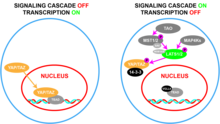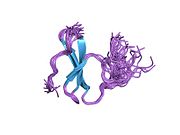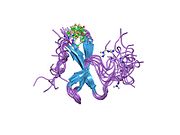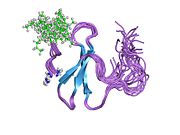YAP1
Ensembl | |||||||||
|---|---|---|---|---|---|---|---|---|---|
| UniProt | |||||||||
| RefSeq (mRNA) |
| ||||||||
| RefSeq (protein) |
| ||||||||
| Location (UCSC) | Chr 11: 102.11 – 102.23 Mb | Chr 9: 7.93 – 8 Mb | |||||||
| PubMed search | [3] | [4] | |||||||
| View/Edit Human | View/Edit Mouse |
YAP1 (yes-associated protein 1), also known as YAP or YAP65, is a protein that acts as a
Structure

Cloning of the YAP1 gene facilitated the identification of a modular
Function
YAP1 is a transcriptional co-activator
It is reported that several genes are regulated by YAP1, including
YAP/TAZ have also been shown to act as stiffness sensors, regulating mechanotransduction independently of the Hippo signalling cascade.[33]
As YAP and TAZ are transcriptional co-activators, they do not have DNA-binding domains. Instead, when inside the nucleus, they regulate gene expression through TEAD1-4 which are sequence-specific transcription factors that mediate the main transcriptional output of the Hippo pathway.
Regulation
Biochemical

At the biochemical level, YAP is part of and regulated by the Hippo signaling pathway where a kinase cascade results in its “inactivation”, along with that of TAZ. The result of the activation of this pathway is the restriction of YAP/TAZ from entering the cell nucleus.
Mechanotransductive
Additionally, YAP is regulated by mechanical cues such as extracellular matrix (ECM) rigidity, strain,
Clinical significance
Cancer
Dysregulation of YAP/TAZ-mediated transcriptional activity is implicated in the development of abnormal cell growth and hyperactivation of YAP and TAZ has been observed amongst many cancers.[49][52][53] Hence YAP1 represents a potential target for the treatment of cancer.[54]
While YAP has been identified as a proto-oncogene, it can also act as a tumor suppressor depending on cellular context.[55]
As a drug target
The YAP1 oncogene serves as a target for the development of new cancer drugs.[56] Small compounds have been identified that disrupt the YAP1-TEAD complex or block the binding function of WW domains.[57][58] These small molecules represent lead compounds for the development of therapies for cancer patients, who harbor amplified or overexpressed YAP oncogene.
Neuroprotection
The Hippo/YAP signaling pathway may exert
Mutations
Heterozygous loss-of-function mutations in the YAP1 gene have been identified in two families with major eye malformations with or without extra-ocular features such as hearing loss, cleft lip, intellectual disability and renal disease.[60]
External links
- Overview of all the structural information available in the PDB for UniProt: P46937 (Human Transcriptional coactivator YAP1) at the PDBe-KB.
- Overview of all the structural information available in the PDB for UniProt: P46938 (Mouse Transcriptional coactivator YAP1) at the PDBe-KB.
References
- ^ a b c GRCh38: Ensembl release 89: ENSG00000137693 – Ensembl, May 2017
- ^ a b c GRCm38: Ensembl release 89: ENSMUSG00000053110 – Ensembl, May 2017
- ^ "Human PubMed Reference:". National Center for Biotechnology Information, U.S. National Library of Medicine.
- ^ "Mouse PubMed Reference:". National Center for Biotechnology Information, U.S. National Library of Medicine.
- ^ PMID 8035999.
- S2CID 14139806.
- PMID 16894141.
- PMID 7846762.
- PMID 7802651.
- S2CID 23110605.
- PMID 7782338.
- PMID 22939869.
- ^ PMID 11358867.
- PMID 8438166.
- S2CID 20803242.
- PMID 10562288.
- ^ PMID 10228168.
- PMID 19141641.
- PMID 12118366.
- PMID 22921829.
- PMID 11278685.
- PMID 12807903.
- PMID 15023535.
- PMID 11278422.
- PMID 18640976.
- PMID 22525271.
- PMID 21187284.
- PMID 21224387.
- PMID 21205866.
- PMID 21685940.
- PMID 20868367.
- ^ PMID 20951342.
- S2CID 39642567.
- PMID 18579750.
- PMID 23725764.
- PMID 26109051.
- PMID 26728553.
- PMID 22075147.
- PMID 22075148.
- S2CID 8261982.
- PMID 18328708.
- PMID 26437443.
- PMID 26364751.
- PMID 17974916.
- ^ PMID 29107331.
- PMID 18654431.
- PMID 15722433.
- ^ PMID 22118458.
- ^ PMID 24380865.
- PMID 23990565.
- S2CID 4470849.
- S2CID 2008641.
- PMID 24336504.
- PMID 25592648.
- PMID 30631509.
- PMID 22609812.
- PMID 22677547.
- PMID 23233876.
- PMID 30092249.
- PMID 24462371.




